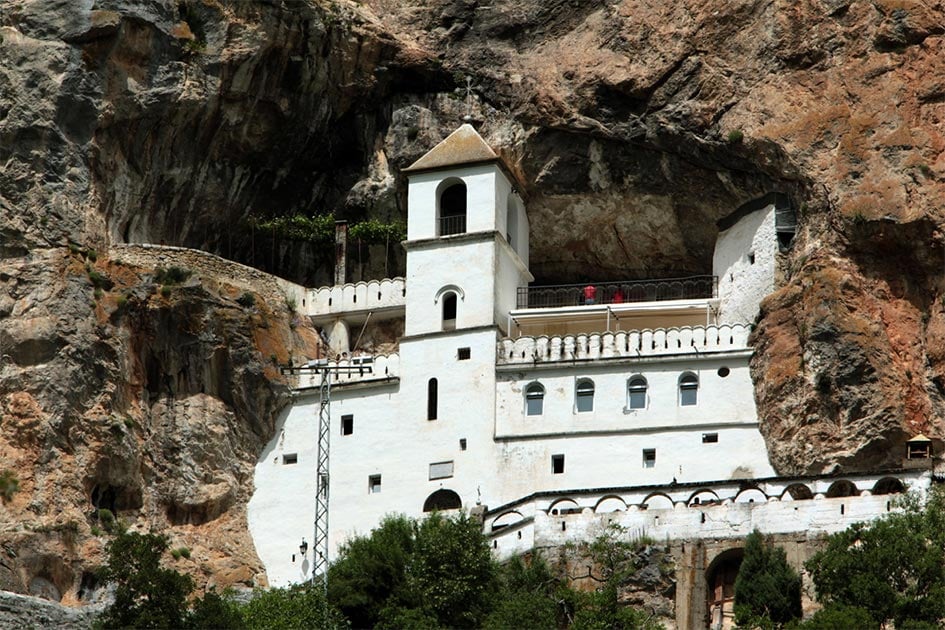Why Ostrog Monastery is a Shining Beacon for Pilgrims
The small republic of Montenegro has a rich and fascinating history with many astounding historic sites that date back to the Classical period. Perhaps the most famous site in all of Montenegro is Ostrog Monastery. This remarkable and beautiful monastery is built into a cavern in an almost vertical rock face.
The History of Ostrog Monastery: Religion and War
There has been a monastery at Ostrog since the Middle Ages, the first built by St Basil of Ostrog. He built on the slopes of the Ostrog ridge and there are many legends told about its construction. Because it was built in a natural fortress, the monastery was also used during times of war. In the 14 th century, the Duke of Montenegro defied the invading Ottoman Turks and as a result Montenegro was never fully incorporated into the Ottoman Empire.
Much of what is now Montenegro was once controlled by clans and bishops. In the mid-17 th century, Vasilije, the Metropolitan Bishop of Herzegovina, ordered the construction of the upper church after another monastery had been destroyed by raiding Ottoman Turks. This was an ambitious project as the large monastery and chapel had to be built into two caves in the mountainside. It was constructed in the tradition of cave-churches which are common in parts of Eastern Europe to this day.

The entire complex of Ostrog Monastery (Naeblys / Adobe Stock)
This construction of the monastery took many years and was completed by the late 17 th century. Bishop Vasilije remains are interred in its chapel. The Ostrog monastery flourished and became an important pilgrimage center. In the 1820s a new church was built on the lower ridge to meet the needs of the increasing number of pilgrims visiting the monastery.
After WWI Montenegro became part of Yugoslavia. During the 1920s the monastery was badly damaged by a fire and much of it had to be rebuild. In 1941, the Germans invaded Yugoslavia, and this led to a brutal conflict. Guerrilla bands fought the Germans and their allies. There was also a civil war between communist and royalist guerrillas (Chetniks) at the same time. In 1943 a detachment of Chetniks used the monastery as their headquarters and were besieged by communist partisans, which culminated in the deaths of all the royalists.
In the aftermath of WWII, the monastery again became a major pilgrimage center. Today it is part of the Serbian Orthodox Church and it is estimated that some 100,000 visitors from around the world visit the site. The natural spring adjacent to the complex is regarded as holy.
The Marvels of Ostrog Monastery
The monastery is a complex of buildings which date from the 17 th to the 21 st century. The lower portion sits on the slopes of the ridge and is just over a mile (2km) below the main shrine. These extensive white building contains the monks' cells as well as a chapel. There are several large-scale frescoes that adorn the exterior of the monastery and other frescoes in the chapel which is the Church of the Holy Trinity.
- Gellert Hill Cave and an Unusual Church with a Brutal History
- Will the Noteworthy Archeological Site of Doclea Be Saved in Time?
- Two Ancient Palaces Unearthed in Montenegro Were Home to Famous Illyrian Rulers

Arch above the gate of Monastery in Ostrog, Montenegro (Tricky Shark / Adobe Stock)
A narrow pathway allows the pilgrim or traveler to reach the Upper Monastery. Mid-way up the ridge is the church of St Stanko the Martyr, which contains the saint’s relics. He was a fifteen-year-old shepherd who refused to reveal the hiding place of the monks despite torture by the Turks. The church has a brilliant golden dome and can be seen for miles around.
The most famous part of the Ostrog complex is the Upper Monastery which is known to locals as ‘Vasilije’s miracle’. The historic building is literally built into a mountain perched high in an almost sheer rock face.

Artwork within the Monastery of Ostrog (Oscar Espinosa/ Adobe Stock)
This part of the monastery is accessed by two flights of steps and is built out of dazzling stone which makes it seem as if it is emerging from the mountainside. Its design is in the traditional Serbian Orthodox architectural style. The monastery has a very impressive bell tower, while inside are several frescoes by the Serbian master painter, Radul. The relics of St Basil of Ostrog are kept in the monastery and they are especially revered. From the site the magnificent Bjelopavlici plain is visible.
Getting to Ostrog Monastery in Montenegro
This monastery is some 27 miles (43 km) from the capital, Podgorica and is near the town of Niksic. While there is no public transport to the site, there are several tours available. Visitors of all faiths are welcome but are expected to act respectfully and to be dressed appropriately.
Top image: Ostrog Monastery in the rocks, Montenegro Source: flu4022 / Adobe Stock
By Ed Whelan
References
Dzankic, J. (2015). Religion and identity in Montenegro. In Monasticism in Eastern Europe and the Former Soviet Republics (pp. 124-143). Routledge < https://www.taylorfrancis.com/books/e/9781315678399/chapters/10.4324/9781315678399-13>
Enich, S. (1990). St. Vasilije of Ostrog Monastery--view from the lower level. The Steven Enich Serbian Orthodox Culture Slide Collection <https://kb.osu.edu/handle/1811/41559>
Popović, M. (2017). Tourist Evaluation of Religious Buildings in Montenegro. Economics, 5(1), 107-124 < https://www.degruyter.com/dg/viewarticle/j$002feoik.2017.5.issue-1$002feoik-2017-0014$002feoik-2017-0014.xml>

















